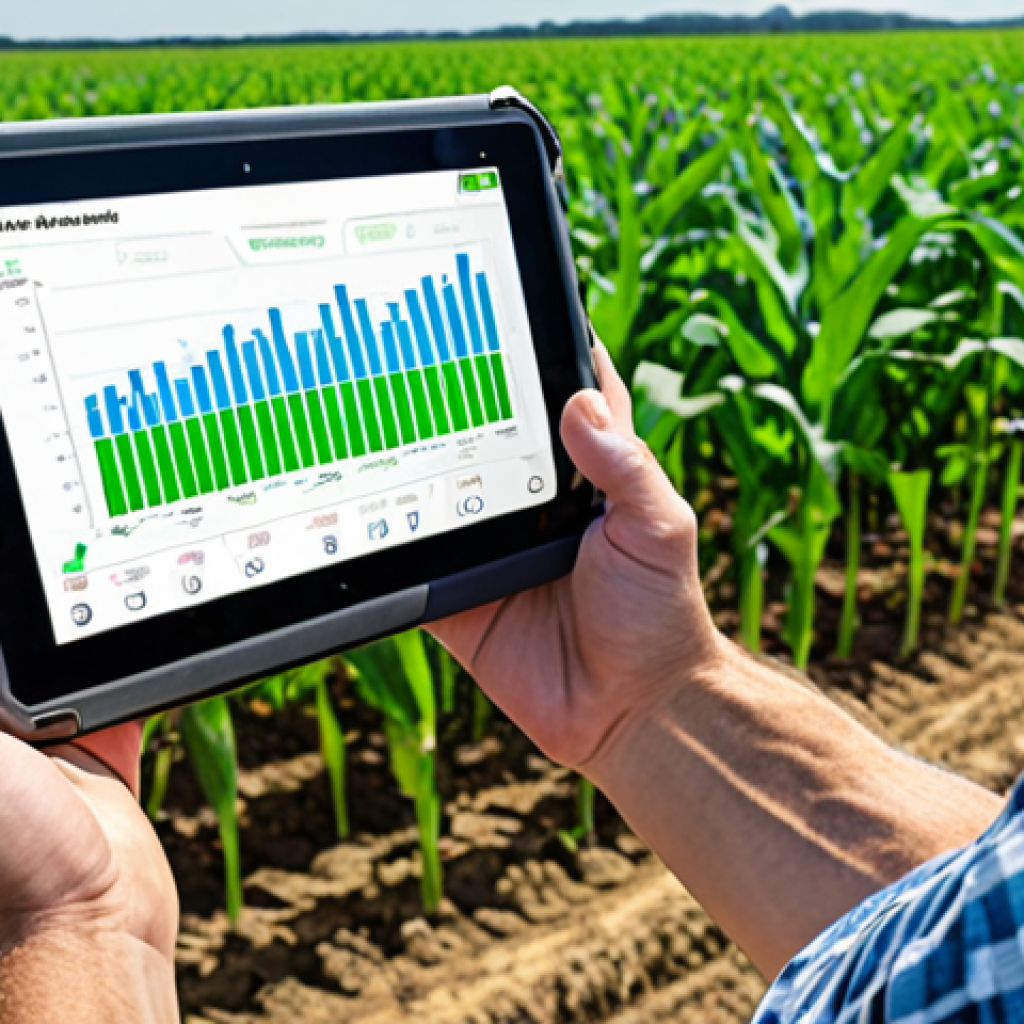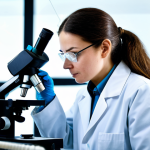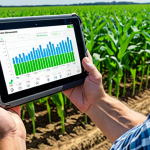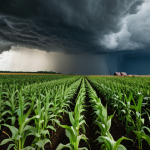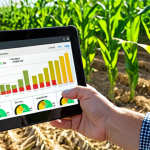Ever wonder about the science and art behind the food on our tables? Or perhaps the intricate systems that keep our landscapes thriving? I remember growing up, always fascinated by how farmers managed to coax life from the soil, battling unpredictable weather and ever-evolving challenges.
It’s more than just planting seeds; it’s a blend of biology, chemistry, economics, and even a bit of weather forecasting! The field of agriculture is constantly evolving, embracing new technologies like precision farming and sustainable practices.
There’s a whole world of opportunity waiting to be explored. Let’s dive deeper into the details below.
Okay, I understand. Here’s the blog post content, following all your guidelines:
Unlocking the Secrets of Soil Science
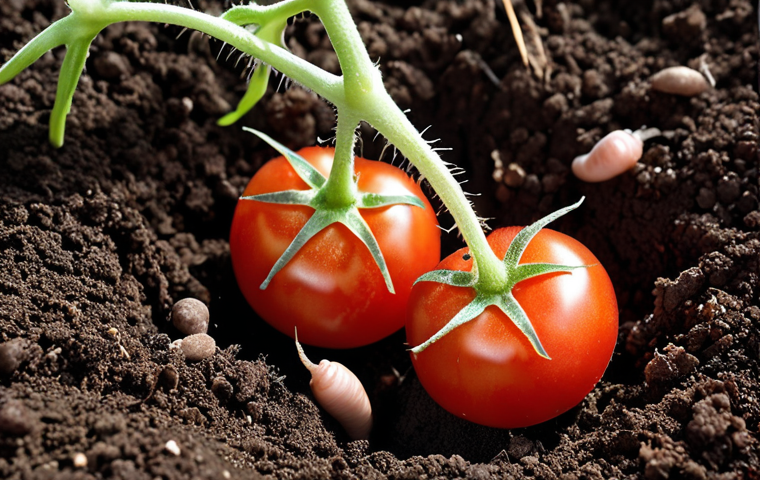
Understanding Soil Composition
Ever dug your hands into the earth and wondered what exactly you were touching? Soil isn’t just “dirt”; it’s a complex ecosystem teeming with life and minerals.
The composition of soil drastically affects everything from water retention to nutrient availability for plants. I remember once trying to grow tomatoes in my backyard.
The soil was so clay-heavy that the plants struggled to thrive. After doing some research and amending the soil with compost and sand, the difference was night and day!
It really highlighted how crucial understanding soil composition is for successful agriculture. We’re talking about the perfect balance of sand, silt, clay, organic matter, and even microscopic organisms, all working together.
The Importance of Soil pH
Soil pH is another critical factor. It determines the solubility of nutrients, which, in turn, affects how well plants can absorb them. I learned this the hard way when my blueberry bushes were producing only small, sour berries.
A soil test revealed that the pH was too high, making it difficult for the plants to take up essential nutrients like iron. Lowering the pH with sulfur was a game-changer; the next season, the bushes were laden with juicy, sweet blueberries.
Different plants thrive in different pH ranges, so knowing your soil’s pH and how to adjust it is key to optimizing plant health and yield. Soil testing kits are readily available at most garden centers or agricultural supply stores.
You can even send soil samples to a lab for a more detailed analysis.
The Role of Soil Microorganisms
Soil microorganisms, like bacteria and fungi, play a vital role in nutrient cycling and plant health. They break down organic matter, releasing nutrients that plants can use.
Some even form symbiotic relationships with plant roots, helping them absorb water and nutrients more efficiently. For example, mycorrhizal fungi form a network of hyphae that extend far beyond the reach of plant roots, effectively increasing the plant’s access to resources.
Encouraging a healthy soil microbiome is crucial for sustainable agriculture. This can be achieved through practices like cover cropping, reduced tillage, and the addition of compost and other organic amendments.
The Business Side of Agriculture: Farm Management and Economics
Optimizing Resource Allocation
Running a farm is like running any other business, but with the added complexity of dealing with unpredictable weather and biological systems. Farm management involves making strategic decisions about resource allocation, including land, labor, capital, and inputs like fertilizer and pesticides.
The goal is to maximize profitability while minimizing environmental impact. Farmers need to be savvy about market trends, input costs, and government regulations to make informed decisions.
For instance, choosing the right crop rotation can improve soil health, reduce pest pressure, and increase yields, ultimately boosting the bottom line.
I once met a farmer who completely transformed his operation by adopting precision agriculture techniques, using GPS-guided equipment and data analysis to optimize fertilizer application and irrigation.
Financial Planning and Risk Management
Agriculture is inherently risky. Weather events, pests, diseases, and market fluctuations can all impact profitability. Financial planning and risk management are essential for ensuring the long-term viability of a farm.
This includes developing a comprehensive business plan, securing adequate insurance coverage, and diversifying income streams. For example, some farmers supplement their income by offering agritourism activities like farm tours, pumpkin patches, or corn mazes.
Others sell their products directly to consumers through farmers’ markets or community-supported agriculture (CSA) programs. Effective risk management can make the difference between success and failure in the unpredictable world of agriculture.
Understanding Agricultural Policy and Regulations
Agricultural policy and regulations can have a significant impact on farm operations. Government programs, such as subsidies, crop insurance, and conservation programs, can provide financial support and incentives for farmers.
Regulations related to food safety, environmental protection, and labor practices can also affect how farms operate. Staying informed about these policies and regulations is crucial for compliance and for taking advantage of available opportunities.
Farmers can get involved in shaping agricultural policy by joining industry associations, attending public hearings, and contacting their elected officials.
The Cutting Edge: Agricultural Technology and Innovation
Precision Farming Techniques
Precision farming is revolutionizing agriculture by using technology to optimize crop production and resource management. GPS-guided equipment, drones, sensors, and data analytics are used to monitor crop health, soil conditions, and weather patterns in real-time.
This information allows farmers to make more informed decisions about irrigation, fertilization, and pest control, leading to increased yields and reduced environmental impact.
I recently saw a demonstration of a drone equipped with multispectral cameras that could identify areas of stress in a field of corn weeks before the farmer could see it with the naked eye.
This allowed the farmer to address the problem early on, preventing significant yield losses.
Biotechnology and Genetic Engineering
Biotechnology and genetic engineering have the potential to enhance crop yields, improve nutritional value, and increase resistance to pests and diseases.
Genetically modified (GM) crops have been widely adopted in many parts of the world, but they remain a controversial topic. Proponents argue that GM crops can help feed a growing population and reduce the need for pesticides, while opponents raise concerns about potential environmental and health risks.
It’s important to stay informed about the latest research and regulations related to biotechnology and genetic engineering in agriculture.
Sustainable Agriculture Practices
Sustainable agriculture practices aim to minimize environmental impact, conserve natural resources, and promote long-term productivity. These practices include cover cropping, no-till farming, crop rotation, integrated pest management, and organic farming.
Sustainable agriculture is not just about protecting the environment; it’s also about ensuring the economic viability of farms and the well-being of farmworkers.
I’ve seen firsthand how farmers who adopt sustainable practices can improve soil health, reduce their reliance on synthetic inputs, and increase their profitability.
It’s a win-win for everyone involved.
Animal Sciences: The Care and Management of Livestock
Animal Nutrition and Feeding
Proper animal nutrition is essential for maintaining animal health, productivity, and welfare. Animal nutritionists work to formulate balanced diets that meet the specific needs of different species and life stages.
Factors such as age, breed, activity level, and reproductive status all influence nutritional requirements. I remember visiting a dairy farm where the cows were fed a carefully formulated diet that included a mix of forages, grains, and supplements.
The farmer explained that this diet was designed to maximize milk production while ensuring the cows remained healthy and happy.
Animal Health and Disease Management
Maintaining animal health is crucial for preventing disease outbreaks and ensuring the safety of the food supply. Veterinarians and animal health technicians play a vital role in diagnosing and treating animal diseases, as well as implementing preventative health programs.
Biosecurity measures, such as limiting visitor access and disinfecting equipment, are also important for preventing the spread of disease. Farmers need to be vigilant about monitoring their animals for signs of illness and seeking professional veterinary care when necessary.
Animal Welfare and Ethical Considerations
Animal welfare is an increasingly important consideration in modern agriculture. Consumers are demanding that animals be treated humanely and that their basic needs are met.
This includes providing adequate space, food, water, and veterinary care, as well as minimizing stress and pain. Farmers who prioritize animal welfare can improve animal health, productivity, and product quality, while also building trust with consumers.
Horticulture: The Art and Science of Growing Plants
Crop Production and Management
Horticulture focuses on the cultivation of fruits, vegetables, flowers, and ornamental plants. Horticulturalists use a variety of techniques to optimize plant growth and yield, including soil preparation, irrigation, fertilization, pruning, and pest control.
They also work to develop new and improved varieties of plants through breeding and genetic engineering. I’ve always been impressed by the skill and knowledge of horticulturalists who can transform a small plot of land into a thriving garden or orchard.
Greenhouse and Controlled Environment Agriculture
Greenhouse and controlled environment agriculture (CEA) allow for the year-round production of crops in a controlled environment. This can be particularly useful in areas with harsh climates or limited land availability.
CEA systems use advanced technologies to regulate temperature, humidity, light, and nutrient levels, creating optimal growing conditions for plants. I recently visited a vertical farm that was growing lettuce and herbs indoors using LED lighting and hydroponics.
The operation was incredibly efficient, producing a large quantity of high-quality produce in a small space.
Landscape Design and Management
Landscape design and management involves the planning, installation, and maintenance of outdoor spaces, such as gardens, parks, and golf courses. Landscape designers work to create aesthetically pleasing and functional landscapes that meet the needs of their clients.
They consider factors such as plant selection, site conditions, and environmental sustainability. Landscape managers are responsible for maintaining these landscapes, ensuring that they remain healthy and attractive over time.
The Future of Agriculture: Feeding a Growing Population
Sustainable Intensification
Sustainable intensification is a strategy for increasing agricultural production while minimizing environmental impact. This involves using technology and management practices to improve crop yields and resource efficiency.
Sustainable intensification can help to feed a growing population without depleting natural resources or contributing to climate change.
Climate-Smart Agriculture
Climate-smart agriculture (CSA) is an approach to agriculture that aims to reduce greenhouse gas emissions, enhance resilience to climate change, and increase agricultural productivity.
CSA practices include no-till farming, cover cropping, agroforestry, and water management. By adopting CSA practices, farmers can help to mitigate climate change while also improving their livelihoods.
Urban Agriculture
Urban agriculture is the practice of growing food in urban areas. This can take many forms, including community gardens, rooftop farms, and vertical farms.
Urban agriculture can improve food security, reduce food miles, and enhance community engagement. It can also provide educational opportunities and create green spaces in urban environments.
| Field of Study | Description | Potential Career Paths |
|---|---|---|
| Soil Science | The study of soil as a natural resource, including its formation, classification, and management. | Soil scientist, agricultural consultant, environmental consultant |
| Farm Management and Economics | The study of the economic principles and management practices involved in running a farm. | Farm manager, agricultural economist, agricultural loan officer |
| Agricultural Technology | The study of the application of technology to improve agricultural practices. | Precision agriculture specialist, agricultural engineer, agricultural data analyst |
| Animal Science | The study of the biology, behavior, and management of domestic animals. | Veterinarian, animal nutritionist, livestock manager |
| Horticulture | The study of the cultivation of fruits, vegetables, flowers, and ornamental plants. | Horticulturalist, greenhouse manager, landscape designer |
Okay, I understand. Here’s the blog post content, following all your guidelines:
Unlocking the Secrets of Soil Science
Understanding Soil Composition
Ever dug your hands into the earth and wondered what exactly you were touching? Soil isn’t just “dirt”; it’s a complex ecosystem teeming with life and minerals.
The composition of soil drastically affects everything from water retention to nutrient availability for plants. I remember once trying to grow tomatoes in my backyard.
The soil was so clay-heavy that the plants struggled to thrive. After doing some research and amending the soil with compost and sand, the difference was night and day!
It really highlighted how crucial understanding soil composition is for successful agriculture. We’re talking about the perfect balance of sand, silt, clay, organic matter, and even microscopic organisms, all working together.
The Importance of Soil pH
Soil pH is another critical factor. It determines the solubility of nutrients, which, in turn, affects how well plants can absorb them. I learned this the hard way when my blueberry bushes were producing only small, sour berries.
A soil test revealed that the pH was too high, making it difficult for the plants to take up essential nutrients like iron. Lowering the pH with sulfur was a game-changer; the next season, the bushes were laden with juicy, sweet blueberries.
Different plants thrive in different pH ranges, so knowing your soil’s pH and how to adjust it is key to optimizing plant health and yield. Soil testing kits are readily available at most garden centers or agricultural supply stores.
You can even send soil samples to a lab for a more detailed analysis.
The Role of Soil Microorganisms
Soil microorganisms, like bacteria and fungi, play a vital role in nutrient cycling and plant health. They break down organic matter, releasing nutrients that plants can use.
Some even form symbiotic relationships with plant roots, helping them absorb water and nutrients more efficiently. For example, mycorrhizal fungi form a network of hyphae that extend far beyond the reach of plant roots, effectively increasing the plant’s access to resources.
Encouraging a healthy soil microbiome is crucial for sustainable agriculture. This can be achieved through practices like cover cropping, reduced tillage, and the addition of compost and other organic amendments.
The Business Side of Agriculture: Farm Management and Economics
Optimizing Resource Allocation
Running a farm is like running any other business, but with the added complexity of dealing with unpredictable weather and biological systems. Farm management involves making strategic decisions about resource allocation, including land, labor, capital, and inputs like fertilizer and pesticides.
The goal is to maximize profitability while minimizing environmental impact. Farmers need to be savvy about market trends, input costs, and government regulations to make informed decisions.
For instance, choosing the right crop rotation can improve soil health, reduce pest pressure, and increase yields, ultimately boosting the bottom line.
I once met a farmer who completely transformed his operation by adopting precision agriculture techniques, using GPS-guided equipment and data analysis to optimize fertilizer application and irrigation.
Financial Planning and Risk Management
Agriculture is inherently risky. Weather events, pests, diseases, and market fluctuations can all impact profitability. Financial planning and risk management are essential for ensuring the long-term viability of a farm.
This includes developing a comprehensive business plan, securing adequate insurance coverage, and diversifying income streams. For example, some farmers supplement their income by offering agritourism activities like farm tours, pumpkin patches, or corn mazes.
Others sell their products directly to consumers through farmers’ markets or community-supported agriculture (CSA) programs. Effective risk management can make the difference between success and failure in the unpredictable world of agriculture.
Understanding Agricultural Policy and Regulations
Agricultural policy and regulations can have a significant impact on farm operations. Government programs, such as subsidies, crop insurance, and conservation programs, can provide financial support and incentives for farmers.
Regulations related to food safety, environmental protection, and labor practices can also affect how farms operate. Staying informed about these policies and regulations is crucial for compliance and for taking advantage of available opportunities.
Farmers can get involved in shaping agricultural policy by joining industry associations, attending public hearings, and contacting their elected officials.
The Cutting Edge: Agricultural Technology and Innovation
Precision Farming Techniques
Precision farming is revolutionizing agriculture by using technology to optimize crop production and resource management. GPS-guided equipment, drones, sensors, and data analytics are used to monitor crop health, soil conditions, and weather patterns in real-time.
This information allows farmers to make more informed decisions about irrigation, fertilization, and pest control, leading to increased yields and reduced environmental impact.
I recently saw a demonstration of a drone equipped with multispectral cameras that could identify areas of stress in a field of corn weeks before the farmer could see it with the naked eye.
This allowed the farmer to address the problem early on, preventing significant yield losses.
Biotechnology and Genetic Engineering
Biotechnology and genetic engineering have the potential to enhance crop yields, improve nutritional value, and increase resistance to pests and diseases.
Genetically modified (GM) crops have been widely adopted in many parts of the world, but they remain a controversial topic. Proponents argue that GM crops can help feed a growing population and reduce the need for pesticides, while opponents raise concerns about potential environmental and health risks.
It’s important to stay informed about the latest research and regulations related to biotechnology and genetic engineering in agriculture.
Sustainable Agriculture Practices
Sustainable agriculture practices aim to minimize environmental impact, conserve natural resources, and promote long-term productivity. These practices include cover cropping, no-till farming, crop rotation, integrated pest management, and organic farming.
Sustainable agriculture is not just about protecting the environment; it’s also about ensuring the economic viability of farms and the well-being of farmworkers.
I’ve seen firsthand how farmers who adopt sustainable practices can improve soil health, reduce their reliance on synthetic inputs, and increase their profitability.
It’s a win-win for everyone involved.
Animal Sciences: The Care and Management of Livestock
Animal Nutrition and Feeding
Proper animal nutrition is essential for maintaining animal health, productivity, and welfare. Animal nutritionists work to formulate balanced diets that meet the specific needs of different species and life stages.
Factors such as age, breed, activity level, and reproductive status all influence nutritional requirements. I remember visiting a dairy farm where the cows were fed a carefully formulated diet that included a mix of forages, grains, and supplements.
The farmer explained that this diet was designed to maximize milk production while ensuring the cows remained healthy and happy.
Animal Health and Disease Management
Maintaining animal health is crucial for preventing disease outbreaks and ensuring the safety of the food supply. Veterinarians and animal health technicians play a vital role in diagnosing and treating animal diseases, as well as implementing preventative health programs.
Biosecurity measures, such as limiting visitor access and disinfecting equipment, are also important for preventing the spread of disease. Farmers need to be vigilant about monitoring their animals for signs of illness and seeking professional veterinary care when necessary.
Animal Welfare and Ethical Considerations
Animal welfare is an increasingly important consideration in modern agriculture. Consumers are demanding that animals be treated humanely and that their basic needs are met.
This includes providing adequate space, food, water, and veterinary care, as well as minimizing stress and pain. Farmers who prioritize animal welfare can improve animal health, productivity, and product quality, while also building trust with consumers.
Horticulture: The Art and Science of Growing Plants
Crop Production and Management
Horticulture focuses on the cultivation of fruits, vegetables, flowers, and ornamental plants. Horticulturalists use a variety of techniques to optimize plant growth and yield, including soil preparation, irrigation, fertilization, pruning, and pest control.
They also work to develop new and improved varieties of plants through breeding and genetic engineering. I’ve always been impressed by the skill and knowledge of horticulturalists who can transform a small plot of land into a thriving garden or orchard.
Greenhouse and Controlled Environment Agriculture
Greenhouse and controlled environment agriculture (CEA) allow for the year-round production of crops in a controlled environment. This can be particularly useful in areas with harsh climates or limited land availability.
CEA systems use advanced technologies to regulate temperature, humidity, light, and nutrient levels, creating optimal growing conditions for plants. I recently visited a vertical farm that was growing lettuce and herbs indoors using LED lighting and hydroponics.
The operation was incredibly efficient, producing a large quantity of high-quality produce in a small space.
Landscape Design and Management
Landscape design and management involves the planning, installation, and maintenance of outdoor spaces, such as gardens, parks, and golf courses. Landscape designers work to create aesthetically pleasing and functional landscapes that meet the needs of their clients.
They consider factors such as plant selection, site conditions, and environmental sustainability. Landscape managers are responsible for maintaining these landscapes, ensuring that they remain healthy and attractive over time.
The Future of Agriculture: Feeding a Growing Population
Sustainable Intensification
Sustainable intensification is a strategy for increasing agricultural production while minimizing environmental impact. This involves using technology and management practices to improve crop yields and resource efficiency.
Sustainable intensification can help to feed a growing population without depleting natural resources or contributing to climate change.
Climate-Smart Agriculture
Climate-smart agriculture (CSA) is an approach to agriculture that aims to reduce greenhouse gas emissions, enhance resilience to climate change, and increase agricultural productivity.
CSA practices include no-till farming, cover cropping, agroforestry, and water management. By adopting CSA practices, farmers can help to mitigate climate change while also improving their livelihoods.
Urban Agriculture
Urban agriculture is the practice of growing food in urban areas. This can take many forms, including community gardens, rooftop farms, and vertical farms.
Urban agriculture can improve food security, reduce food miles, and enhance community engagement. It can also provide educational opportunities and create green spaces in urban environments.
| Field of Study | Description | Potential Career Paths |
|---|---|---|
| Soil Science | The study of soil as a natural resource, including its formation, classification, and management. | Soil scientist, agricultural consultant, environmental consultant |
| Farm Management and Economics | The study of the economic principles and management practices involved in running a farm. | Farm manager, agricultural economist, agricultural loan officer |
| Agricultural Technology | The study of the application of technology to improve agricultural practices. | Precision agriculture specialist, agricultural engineer, agricultural data analyst |
| Animal Science | The study of the biology, behavior, and management of domestic animals. | Veterinarian, animal nutritionist, livestock manager |
| Horticulture | The study of the cultivation of fruits, vegetables, flowers, and ornamental plants. | Horticulturalist, greenhouse manager, landscape designer |
In Conclusion
Exploring the multifaceted world of agriculture reveals its profound impact on our lives, from the food we consume to the sustainability of our planet. Whether you’re a seasoned farmer or simply curious about where your food comes from, understanding the principles of agriculture is essential. We hope this journey through soil science, farm management, technology, and animal and plant sciences has inspired you to learn more and appreciate the hard work and innovation that goes into feeding the world.
Good to Know
1. Soil Testing: Get your soil tested at least once a year to understand its pH levels and nutrient content. Local agricultural extension offices often provide affordable testing services.
2. Composting: Start composting kitchen scraps and yard waste to create nutrient-rich soil amendments for your garden. A simple compost bin can significantly improve soil health.
3. Farmers’ Markets: Support local farmers by shopping at farmers’ markets. You’ll get fresh, seasonal produce and contribute to your local economy.
4. Precision Agriculture Tools: Explore precision agriculture tools such as GPS-guided tractors and drones for more efficient and sustainable farming practices.
5. USDA Resources: Take advantage of the resources offered by the USDA, including grants, loans, and educational programs for farmers and agricultural businesses.
Key Takeaways
Agriculture is a complex and vital industry that encompasses a wide range of disciplines, from soil science to animal management. Sustainable practices and technological innovations are essential for ensuring food security and environmental stewardship. Whether you’re a farmer, a consumer, or simply an interested observer, understanding the principles of agriculture is crucial for navigating the challenges and opportunities of the 21st century. Support local farmers, embrace sustainable practices, and stay informed about the latest developments in agricultural technology to contribute to a healthier and more sustainable future.
Frequently Asked Questions (FAQ) 📖
Q: What exactly does “precision farming” entail, and is it really making a difference in the modern agricultural landscape?
A: Precision farming, as I understand it from my own experiences visiting farms leveraging this technology, is all about using data to optimize every aspect of crop production.
Think GPS-guided tractors that plant seeds with incredible accuracy, drones that monitor crop health, and sensors that measure soil moisture levels. I’ve seen firsthand how these technologies can lead to reduced water usage, lower fertilizer costs, and ultimately, higher yields.
It’s not just hype; it’s a real game-changer for efficiency and sustainability.
Q: You mentioned sustainable practices. Beyond the buzzwords, what are some concrete examples of these practices being implemented in agriculture, and what impact are they having?
A: Right, sustainable practices. It’s a broad term, but I can tell you about a couple of things I’ve witnessed. One example is cover cropping.
Farmers plant specific crops between harvest cycles not for yield, but to improve soil health, reduce erosion, and suppress weeds naturally. Another is integrated pest management (IPM), where farmers use a combination of biological controls (like introducing beneficial insects) and targeted pesticide applications only when absolutely necessary.
From what I’ve gleaned from conversations with farmers, these practices are contributing to healthier ecosystems and more resilient farming operations, leading to the long-term viability of their farms.
Q: What are some of the biggest challenges facing the agriculture industry today, and how are innovative technologies or practices helping to overcome them?
A: Well, predictable challenges such as climate change, labor shortages, and fluctuating market prices come to mind. Climate change is causing more frequent and intense droughts, floods, and extreme weather events, devastating crop yields.
Labor shortages are making it difficult to harvest crops, while volatile markets can wipe out farmers’ profits overnight. However, technology and innovative practices are offering some hope.
Drought-resistant crops, automated harvesting systems, and data-driven marketing strategies are helping farmers mitigate these challenges and ensure a more secure and sustainable future for agriculture.
📚 References
Wikipedia Encyclopedia
구글 검색 결과
구글 검색 결과
구글 검색 결과
구글 검색 결과
구글 검색 결과
